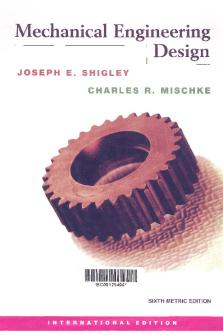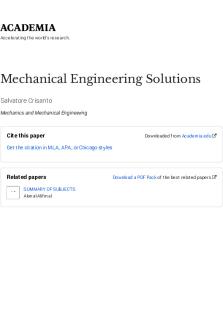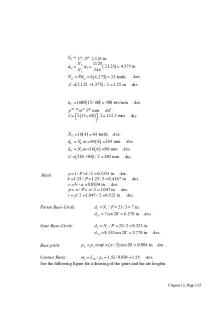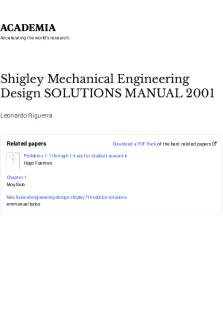Chapter 6 Solutions - solution ofshigley\'s mechanical engineering design PDF

| Title | Chapter 6 Solutions - solution ofshigley\'s mechanical engineering design |
|---|---|
| Course | shigley's solution chapter 6 |
| Institution | الجامعة التكنولوجية (Iraq) |
| Pages | 66 |
| File Size | 1.5 MB |
| File Type | |
| Total Downloads | 55 |
| Total Views | 152 |
Summary
solution ofshigley's mechanical engineering design ...
Description
Chapter 6 6-1
Eq. (2-21): Eq. (6-8): Table 6-2: Eq. (6-19): Eq. (6-20):
Sut 3.4 H B 3.4(300) 1020 MPa Se 0.5 Sut 0.5(1020) 510 MPa a 1.58, b 0.085 k a aS utb 1.58(1020)0.085 0.877 k b 1.24d 0.107 1.24(10)0.107 0.969 Se ka kb Se (0.877)(0.969)(510) 433 MPa
Ans. Eq. (6-18): ______________________________________________________________________________ 6-2
(a) Table A-20: Eq. (6-8):
S ut = 80 kpsi S e 0.5(80) 40 kpsi
Ans .
(b) Table A-20: Eq. (6-8):
S ut = 90 kpsi S e 0.5(90) 45 kpsi
A ns.
(c) Aluminum has no endurance limit. Ans. (d) Eq. (6-8): S ut > 200 kpsi, S e 100 kpsi
A ns.
______________________________________________________________________________ 6-3
Sut 120 kpsi, rev 70 kpsi Fig. 6-18:
f 0.82
Eq. (6-8):
Se Se 0.5(120) 60 kpsi
Eq. (6-14):
a
Eq. (6-15):
f Sut 1 b log 3 Se
( f Sut ) 2 0.82(120) 161.4 kpsi 60 Se 2
1/ b
1 0.82(120) log 0.0716 3 60 1
70 0.0716 N rev Eq. (6-16): 116 700 cycles Ans. 161.4 a ______________________________________________________________________________
6-4
Sut 1600 MPa, rev 900 MPa Fig. 6-18:
S ut = 1600 MPa = 232 kpsi. Off the graph, so estimate f = 0.77.
Eq. (6-8):
S ut > 1400 MPa, so S e = 700 MPa
Eq. (6-14):
( f Sut ) 2 0.77(1600) a 2168.3 MPa Se 700 2
Chapter 6 - Rev. A, Page 1/66
Eq. (6-15):
f Sut 1 1 0.77(1600) b log log 0.081838 3 3 700 Se 1
1/ b
900 0.081838 N rev Eq. (6-16): 46 400 cycles Ans. 2168.3 a ______________________________________________________________________________
6-5
Sut 230 kpsi, N 150 000 cycles Fig. 6-18, point is off the graph, so estimate:
f = 0.77
Eq. (6-8):
S ut > 200 kpsi, so Se Se 100 kpsi
Eq. (6-14):
( f Sut ) 2 0.77(230) a 313.6 kpsi Se 100
Eq. (6-15):
f Sut 1 1 0.77(230) b log log 0.08274 3 3 100 Se
Eq. (6-13):
b 0.08274 117.0 kpsi S f aN 313.6(150 000)
2
Ans .
______________________________________________________________________________ 6-6
Sut 1100 MPa = 160 kpsi Fig. 6-18:
f = 0.79
Eq. (6-8):
Se Se 0.5(1100) 550 MPa
Eq. (6-14):
( f Sut )2 0.79(1100) a 1373 MPa 550 Se
Eq. (6-15):
f Sut 1 1 0.79(1100) b log log 0.06622 3 3 550 Se
Eq. (6-13):
S f aN b 1373(150 000)0.06622 624 MPa
2
Ans .
______________________________________________________________________________ 6-7
Sut 150 kpsi, S yt 135 kpsi, N 500 cycles
Fig. 6-18:
f = 0.798
From Fig. 6-10, we note that below 103 cycles on the S-N diagram constitutes the lowcycle region, in which Eq. (6-17) is applicable.
Chapter 6 - Rev. A, Page 2/66
Eq. (6-17):
log 0.798 /3
S f Sut N log f / 3 150 500
122 kpsi
Ans.
The testing should be done at a completely reversed stress of 122 kpsi, which is below the yield strength, so it is possible. Ans. ______________________________________________________________________________ 6-8
The general equation for a line on a log S f - log N scale is S f = aNb, which is Eq. (6-13). By taking the log of both sides, we can get the equation of the line in slope-intercept form. log S f b log N log a
Substitute the two known points to solve for unknowns a and b. Substituting point (1, S ut ), log Sut b log(1) log a From which a Sut . Substituting point (103 , f Sut ) and a Sut log f Sut b log103 log Sut
From which b 1 / 3 log f
S f Sut N (log f )/3
1 N 103
______________________________________________________________________________ 6-9
Read from graph: 103 ,90 and (106 ,50). From S aN b log S1 log a b log N 1 log S2 log a b log N2 From which log a
log S1 log N2 log S2 log N1 log N 2 / N 1
log 90log106 log 50log103 log10 6 /10 3
2.2095
a 10log a 102.2095 162.0 kpsi log 50 / 90 b 0.0851 3 (S f )ax 162 N 0.0851 103 N 106 in kpsi
Ans.
Chapter 6 - Rev. A, Page 3/66
Check: ( S f ) ax 3 162(103 )0.0851 90 kpsi 10 ( S f ) ax
106
162(106 ) 0.0851 50 kpsi
The end points agree. ______________________________________________________________________________ 6-10
d = 1.5 in, S ut = 110 kpsi Eq. (6-8):
Se 0.5(110) 55 kpsi
Table 6-2: Eq. (6-19):
a = 2.70, b = 0.265 k a aS utb 2.70(110)0.265 0.777
Since the loading situation is not specified, we’ll assume rotating bending or torsion so Eq. (6-20) is applicable. This would be the worst case. k b 0.879d 0.107 0.879(1.5) 0.107 0.842
Eq. (6-18): Se ka kb Se 0.777(0.842)(55) 36.0 kpsi
Ans.
______________________________________________________________________________ 6-11
For AISI 4340 as-forged steel, Eq. (6-8): Table 6-2: Eq. (6-19):
S e = 100 kpsi a = 39.9, b = 0.995 k a = 39.9(260)0.995 = 0.158
Eq. (6-20):
0.75 kb 0.30
0.107
0.907
Each of the other modifying factors is unity. S e = 0.158(0.907)(100) = 14.3 kpsi For AISI 1040: Se 0.5(113) 56.5 kpsi ka 39.9(113)0.995 0.362 kb 0.907 (same as 4340)
Each of the other modifying factors is unity Se 0.362(0.907)(56.5) 18.6 kpsi Not only is AISI 1040 steel a contender, it has a superior endurance strength. ______________________________________________________________________________
Chapter 6 - Rev. A, Page 4/66
6-12
D = 1 in, d = 0.8 in, T = 1800 lbfin, f = 0.9, and from Table A-20 for AISI 1020 CD, S ut = 68 kpsi, and S y = 57 kpsi. r 0.1 D 1 0.125, 1.25, K ts 1.40 (a) Fig. A-15-15: 0.8 d 0.8 d Get the notch sensitivity either from Fig. 6-21, or from the curve-fit Eqs. (6-34) and (6-35b). We’ll use the equations.
a 0.190 2.5110 3 68 1.35 10 5 68 2.67 108 683 0.07335 2
1
qs
a r
1
Eq. (6-32):
1 0.812 0.07335 1 0.1
K fs = 1 + q s (K ts 1) = 1 + 0.812(1.40 1) = 1.32
For a purely reversing torque of T = 1800 lbfin,
a K fs
Tr K fs16T 1.32(16)(1800) 23 635 psi 23.6 kpsi d 3 (0.8) 3 J
Eq. (6-8):
Se 0.5(68) 34 kpsi
Eq. (6-19):
k a = 2.70(68)0.265 = 0.883
Eq. (6-20):
k b = 0.879(0.8)0.107 = 0.900
Eq. (6-26):
k c = 0.59
Eq. (6-18) (labeling for shear):
S se = 0.883(0.900)(0.59)(34) = 15.9 kpsi
For purely reversing torsion, use Eq. (6-54) for the ultimate strength in shear. Eq. (6-54):
S su = 0.67 S ut = 0.67(68) = 45.6 kpsi
Adjusting the fatigue strength equations for shear, 2 2 f Ssu 0.9(45.6) a Eq. (6-14): 105.9 kpsi 15.9 Sse Eq. (6-15):
f Ssu 1 1 0.9(45.6) b log log 0.137 27 3 3 15.9 Sse
Eq. (6-16):
b 23.3 0.137 27 3 N a 61.7 10 cycles a 105.9
1
1
Ans.
Chapter 6 - Rev. A, Page 5/66
(b) For an operating temperature of 750 F, the temperature modification factor, from Table 6-4 is k d = 0.90. S se = 0.883(0.900)(0.59)(0.9)(34) = 14.3 kpsi
f Ssu a
2
Sse
0.9(45.6)
1 f Ssu b log 3 Sse
2
14.3
117.8 kpsi
1 0.9(45.6) log 0.152 62 3 14.3
1
1
b 23.3 0.152 62 3 N a Ans. 40.9 10 cycles a 117.8 ______________________________________________________________________________
6-13
L 0.6 m, Fa 2 kN, n 1.5, N 104 cycles, Sut 770 MPa, Sy 420 MPa(Table A-20) First evaluate the fatigue strength. Se 0.5(770) 385 MPa k a 57.7(770)0.718 0.488
Since the size is not yet known, assume a typical value of k b = 0.85 and check later. All other modifiers are equal to one. Eq. (6-18):
S e = 0.488(0.85)(385) = 160 MPa
In kpsi, S ut = 770/6.89 = 112 kpsi Fig. 6-18: Eq. (6-14): Eq. (6-15): Eq. (6-13):
f = 0.83 2 2 f Sut 0.83(770) a 2553 MPa 160 Se fS 1 1 0.83(770) b log ut log 0.2005 3 3 160 Se b S f aN 2553(104 )0.2005 403 MPa
Now evaluate the stress. M max (2000 N)(0.6 m) 1200 N m
a max
Mc M b / 2 6M 6 1200 7200 3 Pa, with b in m. I b(b3 ) /12 b3 b3 b
Compare strength to stress and solve for the necessary b. Chapter 6 - Rev. A, Page 6/66
n
Sf
a
403 10
6
7200 / b
1.5
3
b = 0.0299 m Select b = 30 mm. Since the size factor was guessed, go back and check it now. 1/2 Eq. (6-25): de 0.808 hb 0.808b 0.808 30 24.24 mm 0.107
24.2 kb 0.88 Eq. (6-20): 7.62 Our guess of 0.85 was slightly conservative, so we will accept the result of
b = 30 mm.
Ans.
Checking yield,
max
7200 10 6 267 MPa 3 0.030
Sy
420 1.57 max 267 ______________________________________________________________________________ ny
6-14
Given: w =2.5 in, t = 3/8 in, d = 0.5 in, n d = 2. From Table A-20, for AISI 1020 CD, S ut = 68 kpsi and S y = 57 kpsi. Eq. (6-8):
Se 0.5(68) 34 kpsi
Table 6-2: Eq. (6-21): Eq. (6-26):
ka 2.70(68) 0.265 0.88 k b = 1 (axial loading) k c = 0.85
Eq. (6-18):
S e = 0.88(1)(0.85)(34) = 25.4 kpsi
Table A-15-1: d / w 0.5 / 2.5 0.2, K t 2.5 Get the notch sensitivity either from Fig. 6-20, or from the curve-fit Eqs. (6-34) and (6-35a). The relatively large radius is off the graph of Fig. 6-20, so we’ll assume the curves continue according to the same trend and use the equations to estimate the notc h sensitivity.
a 0.246 3.08 10 3 68 1.51 10 5 68 2.67 10 8 683 0.09799 2
1 0.836 0.09799 a 1 1 0.25 r K f 1 q ( K t 1) 1 0.836(2.5 1) 2.25
q
Eq. (6-32):
1
Chapter 6 - Rev. A, Page 7/66
Fa 2.25F a = 3Fa A (3 / 8)(2.5 0.5)
a Kf
Since a finit e life was not mentioned, we’ll assume infinite life is desired, so the completely reversed stress must stay below the endurance limit. Se
25.4 2 a 3 Fa Fa 4.23 kips Ans. ______________________________________________________________________________ nf
6-15
Given: D 2 in, d 1.8 in, r 0.1 in, M max 25 000 lbf in, M min 0. From Ta ble A-20, for AISI 1095 HR, S ut = 120 kpsi and S y = 66 kpsi. Eq. (6-8):
Se 0.5 Sut 0.5 120 60 kpsi
Eq. (6-19): Eq. (6-24):
ka aSutb 2.70(120) 0.265 0.76 d e 0.370d 0.370(1.8) 0.666 in
Eq. (6-20):
kb 0.879de 0.107 0.879(0.666) 0.107 0.92
Eq. (6-26):
kc 1
Eq. (6-18):
Se ka kb kc Se (0.76)(0.92)(1)(60) 42.0 kpsi
Fig. A-15-14: D / d 2 /1.8 1.11,
r / d 0.1/ 1.8 0.056
Kt 2.1
Get the notch sensitivity either from Fig. 6-20, or from the curve-fit Eqs. (6-34) and (6-35a). We’ll use the equations.
a 0.246 3.08 10 3 120 1.51 10 5 120 2.67 108 1203 0.04770 2
1
q 1 Eq. (6-32):
a r
1 0.87 0.04770 1 0.1
K f 1 q ( Kt 1) 1 0.87(2.1 1) 1.96
I ( / 64)d 4 ( / 64)(1.8) 4 0.5153 in 4 Mc 25 000(1.8 / 2) 43 664 psi 43.7 kpsi I 0.5153 0
max min
Chapter 6 - Rev. A, Page 8/66
m Kf
Eq. (6-36):
a Kf
max min 2
max min 2
1.96
43.7 0
1.96
2
42.8 kpsi
43.7 0 2
42.8 kpsi
1 a m 42.8 42.8 nf Se Sut 42.0 120
Eq. (6-46):
n f 0.73
Ans.
A factor of safety less than unity indicates a finite life. Check for yielding. It is not necessary to include the stress concentration for static yielding of a ductile material. Sy
66 1.51 A ns. max 43.7 ______________________________________________________________________________ ny
6-16
From a free-body diagram analysis, the bearing reaction forces are found to be 2.1 kN at the left bearing and 3.9 kN at the right bearing. The critical location will be at the shoulder fillet between the 35 mm and the 50 mm diameters, where the bending moment is large, the diameter is smaller, and the stress concentration exists. The bending moment at this point is M = 2.1(200) = 420 kN·mm. With a rotating shaft, the bending stress will be completely reversed.
rev
Mc 420 (35 / 2) 2 0.09978 kN/mm 99.8 MPa 4 I ( / 64)(35)
This stress is far below the yield strength of 390 MPa, so yielding is not predicted. Find the stress concentration factor for the fatigue analysis. Fig. A-15-9: r/d = 3/35 = 0.086, D/d = 50/35 = 1.43, K t =1.7 Get the notch sensitivity either from Fig. 6-20, or from the curve-fit Eqs. (6-34) and (6-35a). We’ll use the equations, with S ut = 470 MPa = 68.2 kpsi and r = 3 mm = 0.118 in.
a 0.246 3.08 10 3 68.2 1.51 10 5 68.2 2.67 108 68.2 0.09771 2
1 0.78 a 1 0.09771 1 0.118 r K f 1 q (K t 1) 1 0.78(1.7 1) 1.55
q
Eq. (6-32):
1
3
Chapter 6 - Rev. A, Page 9/66
Eq. (6-8):
Se' 0.5 Sut 0.5(470) 235 MPa
Eq. (6-19):
ka aSutb 4.51(470) 0.265 0.88
Eq. (6-24): Eq. (6-26):
kb 1.24d 0.107 1.24(35)0.107 0.85 kc 1
Eq. (6-18):
Se ka kb kc Se' (0.88)(0.85)(1)(235) 176 MPa
Se
176 Ans. 1.14 Infinite life is predicted. K f rev 1.55 99.8 ______________________________________________________________________________ nf
6-17
From a free-body diagram analysis, the bearing reaction forces are found to be R A = 2000 lbf and R B = 1500 lbf. The shear-force and bending-moment diagrams are shown. The critical location will be at the shoulder fillet between the 1-5/8 in and the 1-7/8 in diameters, where the bending moment is large, the diameter is smaller, and the stress concentration exists.
M = 16 000 – 500 (2.5) = 14 750 lbf · in With a rotating shaft, the bending stress will be completely reversed. Mc 14 750(1.625 / 2) 35.0 kpsi 4 I ( / 64)(1.625) This stress is far below the yield strength of 71 kpsi, so yielding is not predicted.
rev
Fig. A-15-9: r/d = 0.0625/1.625 = 0.04, D/d = 1.875/1.625 = 1.15, K t =1.95 Get the notch sensitivity either from Fig. 6-20, or from the curve-fit Eqs. (6-34) and (6-35a). We will use the equations.
a 0.246 3.08 10 3 85 1.51 10 5 85 2.67 10 8 85 0.07690 2
1
q
1 0.76 . 0.07690 1 0.0625
Eq. (6-32):
a r K f 1 q( K t 1) 1 0.76(1.95 1) 1.72
Eq. (6-8):
Se' 0.5 Sut 0.5(85) 42.5 kpsi
1
3
Chapter 6 - Rev. A, Page 10/66
Eq. (6-19):
ka aSutb 2.70(85) 0.265 0.832
Eq. (6-20): Eq. (6-26):
kb 0.879 d 0.107 0.879(1.625)0.107 0.835
Eq. (6-18):
Se ka kb kc Se' (0.832)(0.835)(1)(42.5) 29.5 kpsi
kc 1
nf
Se 29.5 0.49 K f rev 1.72 35.0
Ans .
Infinite life is not predicted. Use the S-N diagram to estimate the life. Fig. 6-18: f = 0.867 Eq. (6-14): Eq. (6-15):
f Sut a Se
2
0.867(85) 29.5
fS 1 b log ut 3 Se
2
184.1
1 0.867(85) log 0.1325 3 29.5
1
1
K rev b (1.72)(35.0) 0.1325 N f Eq. (6-16): 4611 cycles 184.1 a N = 4600 cycles Ans. ______________________________________________________________________________ 6-18
From a free-body diagram analysis, the bearing reaction forces are found to be R A = 1600 lbf and R B = 2000 lbf. The shear-force and bending-moment diagrams are shown. The critical location will be at the shoulder fillet between the 1-5/8 in and the 1-7/8 in diameters, where the bending moment is large, the diameter is smaller, and the stress concentration exists. M = 12 800 + 400 (2.5) = 13 800 lbf · in With a rotating shaft, the bending stress will be completely reversed. Mc 13 800(1.625 / 2) rev 4 32.8 kpsi I ( / 64)(1.625) This stress is far below the yield strength of 71 kpsi, so yielding is not predicted. Fig. A-15-9: r/d = 0.0625/1.625 = 0.04, D/d = 1.875/1.625 = 1.15, K t =1.95
Chapter 6 - Rev. A, Page 11/66
Get the notch sensitivity either from Fig. 6-20, or from the curve-fit Eqs. (6-34) and (6-35a). We will use the equations
a 0.246 3.08 10 3 85 1.51 10 5 85 2.67 108 85 0.07690 2
1
3
Eq. (6-32):
1 0.76 a 1 0.07690 1 0.0625 r K f 1 q (K t 1) 1 0.76(1.95 1) 1.72
Eq. (6-8):
S e' 0.5S ut 0.5(85) 42.5 kpsi
Eq. (6-19): Eq. (6-20):
k a aS utb 2.70(85)0.265 0.832 k b 0.879d 0.107 0.879(1.625) 0.107 0.835
Eq. (6-26):
kc 1
Eq. (6-18):
S e k a k bk cS e' (0.832)(0.835)(1)(42.5) 29.5 kpsi
q
nf
Se K f rev
29.5 0.52 1.72 32.8
Ans .
Infinite life is not predicted. Use the S-N diagram to estimate the life. Fig. 6-18: f = 0.867 2 2 f Sut 0.867(85) 184.1 a Eq. (6-14): Se 29.5 Eq. (6-15):
fS 1 b log ut 3 Se 1
Similar Free PDFs

Mechanical engineering design
- 6 Pages

Mechanical Engineering Solutions
- 21 Pages

Mechanical-engineering
- 1 Pages

Mechanical engineering
- 1 Pages
Popular Institutions
- Tinajero National High School - Annex
- Politeknik Caltex Riau
- Yokohama City University
- SGT University
- University of Al-Qadisiyah
- Divine Word College of Vigan
- Techniek College Rotterdam
- Universidade de Santiago
- Universiti Teknologi MARA Cawangan Johor Kampus Pasir Gudang
- Poltekkes Kemenkes Yogyakarta
- Baguio City National High School
- Colegio san marcos
- preparatoria uno
- Centro de Bachillerato Tecnológico Industrial y de Servicios No. 107
- Dalian Maritime University
- Quang Trung Secondary School
- Colegio Tecnológico en Informática
- Corporación Regional de Educación Superior
- Grupo CEDVA
- Dar Al Uloom University
- Centro de Estudios Preuniversitarios de la Universidad Nacional de Ingeniería
- 上智大学
- Aakash International School, Nuna Majara
- San Felipe Neri Catholic School
- Kang Chiao International School - New Taipei City
- Misamis Occidental National High School
- Institución Educativa Escuela Normal Juan Ladrilleros
- Kolehiyo ng Pantukan
- Batanes State College
- Instituto Continental
- Sekolah Menengah Kejuruan Kesehatan Kaltara (Tarakan)
- Colegio de La Inmaculada Concepcion - Cebu











